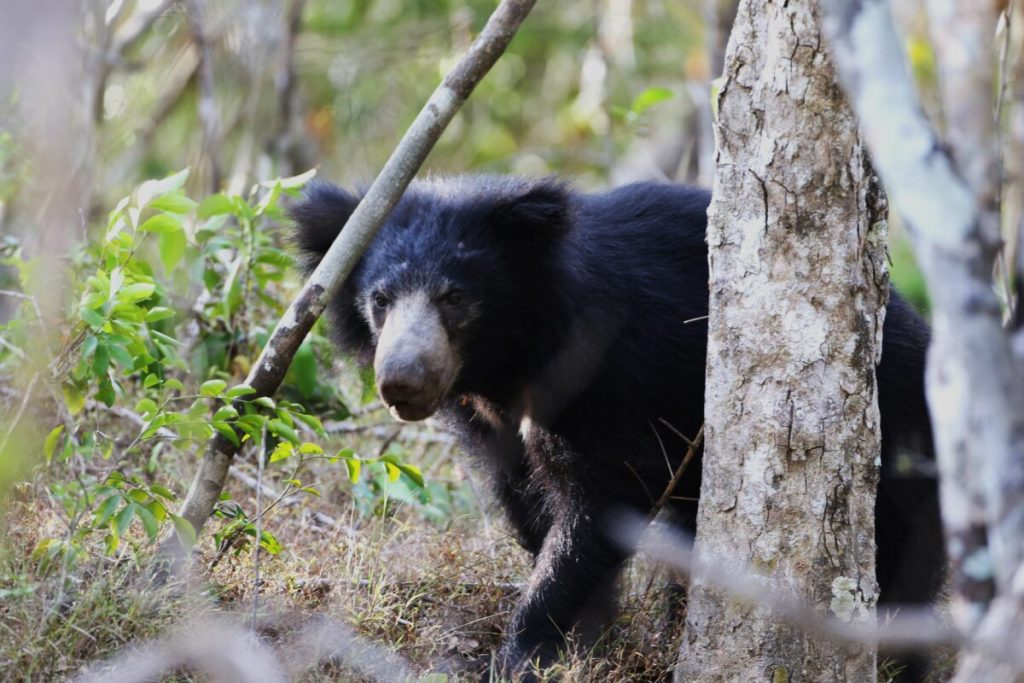- Wilpattu National Park, Sri Lanka’s largest and a prime location for year-round sloth bear sightings, has sparked concern after the sudden deaths of three sloth bears (Melursus ursinus inornatus) occurred within a span of a few weeks.
- As sloth bears like to feed on carrion, there are often concerns about these animals contracting swine flu, which is generally present in wild boar populations due to consumption of carcasses, posing a risk of zoonotic transmission.
- Veterinary surgeons are awaiting laboratory analysis of the recently dead bear’s organ samples to finalize the autopsy report, but they indicate that tick fever is a likely cause of death due to heavy tick infestation.
- The sloth bear is an elusive and iconic species, recognized as a key wildlife attraction and a member of Sri Lanka’s “Big Five” wildlife species, alongside the elephant and leopard, making its conservation essential to the country’s nature-based tourism industry.
Wilpattu, SRI LANKA – After a fruitful safari at Wilpattu National Park, wildlife photographer Rohan Fonseka and his colleagues ventured toward the Maradanmaduwa area, hoping to catch a glimpse of a sloth bear. Their luck held as a full-grown bear emerged from the dry zone forest, offering rare and memorable photo opportunities. But what seemed like a rewarding end to the day turned tragic the next morning, when the same bear’s lifeless body was found near the corridor of the Maradanmaduwa wildlife circuit bungalow.
It was the second sloth bear death reported in Wilpattu in March, as just two weeks prior, a cub had been discovered dead, park warden Suranga Rathnayake confirmed. In January, another cub was also found dead, bringing this quarter’s death toll of sloth bears within the park to three.

These consecutive deaths have raised alarm among conservationists, particularly as sloth bears (Melursus ursinus inornatus) are elusive and rare in Sri Lanka. The Department of Wildlife Conservation (DWC) had warned in December 2024 of an outbreak of African swine fever (ASF) among wild boars. As opportunistic feeders, sloth bears are known to scavenge carrion, which causes concern of possible zoonotic transmission of ASF to these sloth bears.
Wildlife veterinarian Chandana Jayasinghe, who oversees Wilpattu for the DWC, told Mongabay, “So far, we have no evidence of African swine fever transmission to other species.” However, the bear carcasses were heavily infested with ticks, pointing toward possible infection of tick fever, which is a common cause of illness and death in wild mammals. Full confirmation is pending laboratory analysis of tissue samples, said Jayasinghe, who overlooked the postmortem examinations of the three dead bears.

A shy and charismatic umbrella species
The Sri Lankan sloth bear is a dry zone forest specialist, found only on the Indian Ocean island and classified as a subspecies of the Indian sloth bear (M. ursinus). Recognized by its shaggy black coat and distinctive white chest patch, it is nocturnal, reclusive and smaller than its Indian counterpart by as much as 20%, according to biologist and avid sloth bear researcher Shyamala Ratnayeke of Allegany College of Maryland.

“The first specimen of this species received by the British Museum centuries ago was mistaken for a sloth in Africa because of its shaggy coat and long claws. That’s how it ended up with the name ‘sloth bear,’” Ratnayeke told Mongabay.
Sloth bears are also noted for their maternal care. Mothers carry their cubs on their backs for the first few months — a behavior known as “piggybacking” — and continue to support them until they can forage independently.

Termite mounds and palu trees
Sloth bear feeds primarily on insects, especially termites and ants. Their powerful forelimbs, long and curved claws and specially adapted lips allow them to suck insects from nests with remarkable efficiency. “It’s like watching a vacuum cleaner in action,” Ratnayeke said.
In addition to insects and sometimes carrion, sloth bears are fond of seasonal fruits, especially those of the Ceylon ironwood tree (Manilkara hexandra), locally known as palu, which dominates Sri Lanka’s dry zone forests. The palu fruiting season, which spans from May to July, is considered the best time to observe sloth bears in the wild, said Mevan Piyasena, a freelance naturalist who regularly guides tourists in Sri Lanka’s national parks.
“During fruiting season, they seem to appear from nowhere,” Piyasena told Mongabay. “Sometimes, several bears are seen feeding on the same tree, and they seem to have specific trees they prefer over others, particularly those in in the coastal areas,” Piyasena observed.

Vital to tourism, but losing ground
The sloth bear is one of Sri Lanka’s “Big Five” species, alongside the elephant and leopard, and holds major appeal for nature-based tourism. Despite its elusive nature, the sighting of a sloth bear is a highly prized experience for wildlife enthusiasts and photographers.
Yet this bear’s survival is increasingly uncertain. The primary threat is habitat loss. As dry zone forests are cleared for agriculture, settlements and infrastructure development, the sloth bear’s range is rapidly shrinking. Research by Ratnayeke two decades ago found that only 43% of the bear’s historical range remained viable. That figure is feared to be even lower today.

Human-wildlife conflict adds another layer of pressure. “Our data show 271 reported sloth bear attacks between 1938 and 2004, and 98% of the victims were men,” Ratnayeke said. “Almost all these incidents occurred in forested areas where men go to collect honey or to hunt. These are mostly surprise encounters, and most often the attacks are deadly when men travel alone rather than in groups.”
Meanwhile, Ranil Nanayakkara, a conservation biologist at Biodiversity Education And Research (known as BEAR) who continues to study sloth bears in Wilpattu, said that some bears in the area appear to show signs of physical weakness, making them more susceptible to infestations. He suggests this vulnerability could be linked to a decline in their primary food source: termites.
“In our study, we observed that the bears are spending noticeably less time at termite mounds, which may indicate a reduction in termite availability,” Nanayakkara told Mongabay. “There could also be a climate change-related factor at play, as shifting weather patterns may be impacting ant and termite populations.”

Urgent need for conservation attention
The Sri Lankan sloth bear is listed as vulnerable on the IUCN Red List and nationally considered endangered. Its limited range, low population and specific habitat requirements make it particularly susceptible to extinction.
The recent deaths in Wilpattu underscore the urgent need for closer monitoring of bear populations, improved disease surveillance and better management of human-wildlife interactions. While the cause of death is still being investigated, conservationists hope these tragic losses will prompt renewed efforts to safeguard one of Sri Lanka’s most unique and endangered mammals.
Banner image: Up close and personal. A sloth bear in the wilds of Wilpattu in Sri Lanka. Image courtesy of Ranil Nanayakkara.








